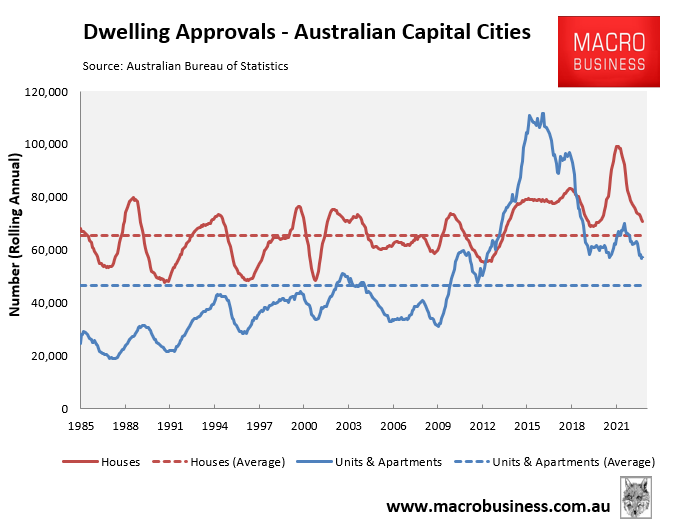YIMBYs, policy makers, the mainstream media, think tanks, and developers are lobbying Australia’s governments to loosen planning laws so that hundreds of thousands of apartments can be built across the ‘missing middle’ of the nation’s major cities.
Their arguments dismiss ample empirical evidence showing the last decade’s high-rise apartment boom was a disaster.

Australians witnessed reams of reports on the ‘problem’ of combustible and faulty apartments across Australia’s cities in the run-up to the COVID-19 outbreak.
Building regulation consultant Bronwyn Weir warned that “thousands and thousands of apartments have serious defects in their buildings. [The problem] is enormous”.
“We have what is now you know, a systemic failure that is quite difficult to unravel”.
“Some of these buildings could potentially be a write-off”, she said.
A study conducted by the Strata Community Association NSW in October 2021 found nearly four out of every ten new apartment complexes in the state had major flaws.
The study was conducted in response to the discovery of serious structural flaws at Mascot Towers and Opal Tower, which resulted in their temporary evacuation.
A NSW parliamentary inquiry likewise uncovered significant flaws in new apartment complexes.
Across Melbourne, similar systemic problems have been uncovered.
The Age recently reported that “inspections of 339 buildings that received government funding to remove flammable cladding found half had other faults and one-in-four had balcony defects”.
“More than 550 balconies were found to be defective”.
“Cladding Safety Victoria is concerned that the situation in relation to defective balconies is widespread and has proliferated over at least two decades”.
“They have been built to an absolute minimum price and a minimum standard”, said Paul Viney, Victorian president of the Association of Consulting Architects.
“I think we will continue to see significant numbers of building defects emerge”.
The Age also reported that “Victoria is facing a crisis of leaky buildings, with construction experts blaming a lack of regulation of waterproofing”.
This month, the ABC reported that NSW Fair Trading has issued more than 30 work rectification orders across building sites, some for “potential serious defects”.
Engineer Leith Dawes said that it remained a game of “Russian roulette” when purchasing off-the-plan.
Over the weekend, WSWS reported that the owners of 276 apartments in Sydney’s inner west Vicinity complex are facing a $50 million repair bill for building defects.
The three-story complex was built by Toplace, which recently went into administration after its building licence was suspended due to severe flaws uncovered in many apartment buildings completed by the company throughout Sydney.
Engineers have discovered “concrete cancer” — rusting of steel reinforcement — in certain internal columns, and more are being investigated. The owners’ corporation was required to erect six large temporary columns on three floors to support the structure, which they had been warned was prone to collapsing.
The proliferation of defective apartments was fuelled by 15 years of pre-pandemic hyper-immigration, which necessitated the construction of tens of thousands of more homes each year, resulting in speed over quality and deteriorated building standards.
The bulk of housing erected in Australia’s capital cities over the last decade were units and apartments, as shown in the chart above.
The Albanese Government has now opened the floodgates to immigration, with a record 1.5 million net overseas migrants projected in the federal budget to arrive in Australia by 2026-27, with the vast majority settling in major capital cities:

Source: 2023 Federal Budget
What will happen when Australia needs to quickly increase housing supply to accommodate historically high levels of immigration? Do we believe standards will remain stable, deteriorate, or improve?
The answer is self-evident: building standards will be trashed even further in order to build apartments as quickly as possible to house the ballooning population.
More shoddy high-rise apartments will be built across Australia’s cities to accommodate the Albanese Government’s reckless mass immigration policy.

